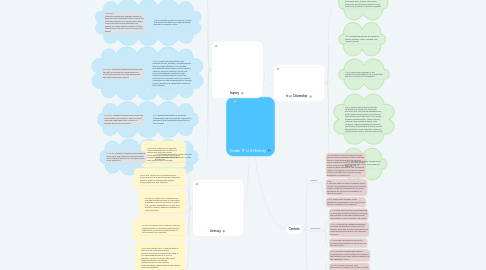
1. Inquiry
1.1. 11.5.4: Analyze the passage of the Nineteenth Amendment and the changing role of women in society.
1.1.1. H-SS AS: Students identify bias and prejudice in historical interpretations.
1.2. 11.5.6:Trace the growth and effects of radio and movies and their role in the worldwide diffusion of popular culture.
1.2.1. H-SS AS: Students analyze how change happens at different rates at different times; understand that some aspects can change while others remain the same; and understand that change is complicated and affects not only technology and politics but also values and beliefs.
1.3. 11.5.2: Analyze the international and domestic events, interests, and philosophies that prompted attacks on civil liberties, including the Palmer Raids, Marcus Garvey’s “back-to-Africa” movement, the Ku Klux Klan, and immigration quotas and the responses of organizations such as the American Civil Liberties Union, the National Association for the Advancement of Colored People, and the Anti-Defamation League to those attacks.
1.3.1. H-SS AS: Students compare the present with the past, evaluating the consequences of past events and decisions and determining the lessons that were learned.
1.4. 11.7.1:Examine the origins of American involvement in the war, with an emphasis on the events that precipitated the attack on Pearl Harbor.
1.4.1. H-SS AS: Students interpret past events and issues within the context in which an event unfolded rather than solely in terms of present-day norms and values.
1.5. 11.4.5:Analyze the political, economic, and social ramifications of World War I on the home front.
1.5.1. H-SS AS: Students understand the meaning, implication, and impact of historical events and recognize that events could have taken other directions.
2. Literacy
2.1. CCSS.ELA Literacy RS3: Evaluate various explanations for actions or events and determine which explanation best accords with textual evidence, acknowledging where the text leaves matters uncertain.
2.2. CCSS.ELA Literacy RS6: Evaluate authors’ differing points of view on the same historical event or issue by assessing the authors’ claims, reasoning, and evidence.
2.3. CCSS.ELA Literacy RS7: Integrate and evaluate multiple sources of information presented in diverse formats and media (e.g., visually, quantitatively, as well as in words) in order to address a question or solve a problem.
2.4. CCSS.ELA Literacy WS4: Produce clear and coherent writing in which the development, organization, and style are appropriate to task, purpose, and audience.
2.5. CCSS.ELA Literacy WS7: Conduct short as well as more sustained research projects to answer a question (including a self-generated question) or solve a problem; narrow or broaden the inquiry when appropriate; synthesize multiple sources on the subject, demonstrating understanding of the subject under investigation.
3. Content
3.1. History
3.1.1. 11.3.2:Analyze the great religious revivals and the leaders involved in them, including the First Great Awakening, the Second Great Awakening, the Civil War revivals, the Social Gospel Movement, the rise of Christian liberal theology in the nineteenth century, the impact of the Second Vatican Council, and the rise of Christian funda mentalism in current times.
3.1.2. 11.3.5: 5. Describe the principles of religious liberty found in the Establishment and Free Exercise clauses of the First Amendment, including the debate on the issue of separation of church and state.
3.1.3. 11.5.3: Examine the passage of the Eighteenth Amendment to the Constitution and the Volstead Act (Prohibition).
3.2. Economics
3.2.1. 11.2.1: Know the effects of industrialization on living and working conditions, including the portrayal of working conditions and food safety in Upton Sinclair’s The Jungle.
3.2.2. 11.2.2: Describe the changing landscape, including the growth of cities linked by industry and trade, and the development of cities divided according to race, ethnicity, and class.
3.2.3. 11.4.5:Analyze the political, economic, and social ramifications of World War I on the home front.
3.3. Geography
3.3.1. 11.3.4:Discuss the expanding religious pluralism in the United States and California that resulted from large-scale immigration in the twentieth century.
3.3.2. 11.5.7:7. Discuss the rise of mass production techniques, the growth of cities, the impact of new technologies (e.g., the automobile, electricity), and the resulting prosperity and effect on the American landscape.
3.3.3. 11.6.3: 3. Discuss the human toll of the Depression, natural disasters, and unwise agricultural practices and their effects on the depopulation of rural regions and on political movements of the left and right, with particular attention to the Dust Bowl refugees and their social and economic impacts in California.
